Table of contents
The mango ( Mangifera indica ) is a tropical fruit that is popular worldwide and can be eaten raw or cooked. Organic mangos have a much better ecological footprint.
Using mango in the kitchen:
Fresh and ripe mangos smell very aromatic and taste pleasantly sweet, sometimes with a slightly bitter note in the finish.
Can you eat mango raw? Mangos can be eaten raw. Can you eat the mango with the peel? Neither the mango peel nor the pit is edible. The peel can be removed with a vegetable peeler.
When is a mango ripe? You can tell that a mango is ripe because it gives way when gently pressed and gives off a pleasant aroma. Small black dots (1-4 mm) on the skin are also an indication of ripeness. Neither the color of the skin nor the flesh of the fruit says anything about ripeness.
Can you eat an unripe mango? It is common to eat a mango when it is ripe, but a mango can also be eaten unripe, as is popular in Thailand and the Philippines 1 (in various traditional recipes).
There are different ways to eat whole mangos. How do you cut a mango? You can peel the whole mango, stand it upright and cut the flesh off slice by slice. Should you cut the mango in half to get the pit out? Or you can cut a piece off to the right and left past the pit. Then you can use a sharp knife to cut the flesh in a "checkered pattern" down to the skin (lengthways and crossways). You can then turn the skin inside out and separate the mango cubes by hand or cut them off and eat them. To get the pit out, it is best to cut off the remaining flesh around the pit.
The mango fruit, with its sweetness and freshness, is ideal for all kinds of vegan dessert creations, such as ice cream (sorbet), fruit salad, cream, tarts and cakes. A typical Thai dessert is sticky rice with mango (sometimes prepared with lemongrass ). Mango can be used to make wonderful juice, smoothies (e.g. withraspberries ) and lassis (Indian yoghurt drinks, also vegan). How do you use ripe mangos? Ripe mangos in particular are suitable for jam, compote, chutneys and the Indian speciality 'mango pickle' (or 'mango pickles' = pickled mango pieces with Indian spices).
You can also use mango to make wonderful salads and other raw food dishes. Mango pieces look fantastic in vegan sushi. But the fruit is also ideal for hearty, salty dishes. Curries with vegetables and tofu , stuffed zucchini , pasta dishes, soups (e.g. with carrots and curry ), sandwiches, wraps (e.g. mango wraps with young coconut meat, vegetables and herbs ), sauces, dips (e.g. mango-pineapple salsa or strawberry-mango guacamole ) and much more can be spiced up with mango.
Vegan recipe for mango-avocado salad:
Ingredients (for 2 people): 1 mango (raw, organic), 1 avocado , 150 g rocket , 1 orange , ½ lime , 2 tbsp rapeseed oil , 2 tbsp white balsamic vinegar , possibly 1 tsp agave syrup , 1 pinch of chili powder , some salt andpepper .
Preparation: Peel the raw mango and cut into pieces (remove the pit). Peel and dice the avocado. Wash the rocket well and drain. Put the mango, avocado and rocket in a bowl and mix everything together. For the dressing, squeeze the orange and half a lime and mix the juices with rapeseed oil, white balsamic vinegar (and agave syrup). Season the dressing with salt, pepper and chili powder and carefully fold into the raw vegan mango and avocado salad.
Vegan recipes with mango (raw) can be found under the note: " Recipes that have the most of this ingredient ".
| Not only vegans or vegetarians should read this: Vegans often eat unhealthily. Avoidable nutritional mistakes . |
Shopping - where to buy mangos?
Although raw mangos are considered a little difficult to find in stores due to their sensitivity to pressure, the exotic fruit can be found in European supermarkets such as Coop , Migros , Denner , Volg , Spar , Aldi , Lidl , Rewe , Edeka , Hofer , Billa mostly all year round, often in organic quality. In organic supermarkets (such as Denn's Biomarkt , Alnatura ), fresh mangos are often not available all year round, but all kinds of other organic mango products (organic) are, such as dried mango slices , frozen mango cubes or mango juice.
Found in the wild:
The natural distribution area of the Mangifera indica is in the so-called Oriental region, particularly in the Assam-Chittagong Hills in India and in Myanmar, where wild populations can still be found. The mango plant has been able to naturalize and spread in the tropics and subtropics due to the spread of humans and the associated globalization. 1
Storage:
Ripe mangos taste best when fresh or when consumed within three days. The fruit should be stored at room temperature and not in the refrigerator, as temperatures below 8 °C are not good for the taste and appearance of a mango. Unripe mangos can ripen. To do this, you can wrap them in newspaper and leave them. If you are in a hurry, place them next to other climacteric fruits (eg apples ) that give off the gas ethylene. This speeds up the ripening process.
Mango ingredients - nutritional values - calories:
Mango (raw) contains 60 kcal per 100 g, which mainly come from carbohydrates. Of these 15 g of carbohydrates per 100 g, 14 g are sugar, which covers 15.2% of the daily requirement. The fat content is low at 0.38 g/100g, as is the protein content at 0.82 g/100g. 2
Does mango contain vitamins and healthy nutrients? Raw mangoes contain 36 mg of vitamin C (ascorbic acid) per 100 g, which is 46% of the daily requirement. Black mulberries (36 mg/100g) and grapefruit (34 mg/100g) have comparable amounts. Sea buckthorn berries contain more than 12 times as much, at 450 mg/100g. 2
Raw mango contains 43 µg/100g of folate (folic acid) (22% of the daily requirement). Guavas (49 µg/100g) and pomegranates (38 µg/100g) contain a similar amount. Mung beans (625 µg/100g) contain a lot of folate - but these have to be germinated or cooked, which reduces the content. We therefore also mention avocado with 81 µg/100g as a comparison. 2
The vitamin B 6 (pyridoxine) content is 0.12 mg/100g (9% of the daily requirement). This is comparable to that of figs (0.11 mg/100g) and pineapple (0.11 mg/100g). Yeast flakes contain a lot of vitamin B 6 at 2.9 mg/100g, but only small amounts are eaten. As far as fruit is concerned, bananas have an even higher content at 0.37 mg/100g. 2
The complete ingredients of Mango (raw), the coverage of the daily requirement and comparison values with other ingredients can be found in our nutrient tables. In the article Nutrients explained you will get a detailed insight into the topic.
Dangers - Intolerances - Side effects:
Is an unripe mango poisonous? No, unripe mangos are not poisonous (see above in the chapter "Use in the kitchen"). However, substances found in the bark, leaves and peel (especially in unripe mangos) can trigger allergies and intolerances. The so-called urushiols (natural contact allergens) are found specifically in sumac plants, to which mangos also belong. They can lead to severe allergic reactions (mango dermatitis). This is often the case in growing areas where people are constantly in contact with mangos and their peels during the harvest. 6
Caution is also advised if you are allergic to another sumac plant (eg cashew nuts or poison ivy). Cross-allergies with respiratory allergens such as birch pollen, mugwort, celery and carrots can also occur. People with a latex allergy can react to certain foods, including mangoes. 7
Mangos, like other fruits, contain fructose. People with fructose malabsorption should therefore avoid eating mangos. In fructose malabsorption, the function of the fructose transport molecule is impaired, meaning that the intestinal cells cannot absorb enough of the fruit sugar (fructose). In this case, consuming fructose can lead to diarrhea, abdominal cramps, constipation, nausea, malaise, belching and flatulence. The tolerable threshold of fructose varies from person to person. 8
Health aspects - effects:
Is the mango fruit healthy? Mangifera indica has both health-promoting and disease-preventing effects that are attributed to a number of bioactive secondary plant substances. These include carotenoids, polyphenols, phytosterols and terpenoids, which are found in various parts of the mango plant, including the fruit. 3 The polyphenol mangiferin contained in mangos (mainly in the leaves and bark) is an antioxidant and also has antidiabetic, antihypertensive, antidegenerative, immunomodulatory, cardiotonic and wound-healing effects. 4
Mango fruits also have antibacterial, antifungal, antiviral and anti-inflammatory properties. 4 Studies have also shown that mangoes can be used to treat cancer and obesity. 3
In addition, mangos are recommended for skin diseases (e.g. eczema, dermatoses), dry skin and to prevent premature skin aging due to their ingredients (especially vitamin A). The vitamins contained in mangos (especially vitamin A , vitamin C and vitamin E ) are also useful for retinal diseases. They help with night blindness, optic nerve atrophy and thrombosis of the central retinal artery. The ingredients in mangos are also said to have a diuretic effect and lower blood pressure. 5
Folk medicine - naturopathy:
In traditional Chinese medicine ( TCM ), mangos are used for thirst, nausea, vomiting, motion sickness and coughs with mucus expectoration. 9
Occurrence - origin - ecology:
Mango plants originally come from the low mountain ranges of Burma and the foothills of the Himalayas in eastern India. The fruit has been cultivated in India for more than 4,000 years. 10 From there, it spread through humans in the last two centuries. Today, the fruit can be found in all tropical and subtropical regions. In addition to India, mangos are also grown in China, the Philippines, Thailand, East and West Africa, the southern USA and the Persian Gulf region, as well as in southern Brazil, Australia, Hawaii and Pakistan. Mangos are also grown in Europe: on the Canary Islands, Madeira and along the Mediterranean coast. 1,3
After the banana, the mango is the most widely cultivated tropical fruit, with an annual production of around 42 million tons. 3
Growing in the garden or as a potted plant:
You can grow a mango plant from a mango seed, which will hardly bear any fruit but will still look nice. To do this, you should use a ripe organic mango. First, remove the seed and carefully open it with the tip of a knife, as the kidney-shaped seed is inside. Wrap the seed in a damp cloth, put it in a sealable freezer bag and leave it to rest for around 10 days. The resulting seedling can then be planted. It is best to plant it in a pot with a drainage layer made of expanded clay or clay shards, a substrate and an organic fertilizer. Place the pot in a mini greenhouse where the conditions are ideal for growth (25-30 °C). The whole thing should be in a bright place. Air the greenhouse regularly and spray the plant with water. 11
Cultivation - Harvest:
Mangos grow best in warm, tropical areas. Mango trees are drought-resistant and have low soil requirements. After about five years, the tree bears its first fruits. It takes between 12 and 15 years for the tree to fully ripen. There are over 1000 different types of mango, which differ in their shape, size, texture, taste and climate requirements. 12
Ecological aspects:
In contrast to conventional cultivation, no chemicals or pesticides are used in organic mango cultivation . In addition to pesticide residues , conventional plantations are repeatedly criticized for poor working conditions. 13
The so-called "air-flighted mangos" are particularly harmful to the environment and the climate. Air-flighted mangos are mangos that are allowed to ripen completely on the tree due to the short transport time by plane. These mangos have a more intense aroma than early-harvested mangos that are sent by ship. However, air-flighted mangos are more expensive and cause large amounts of greenhouse gases. Prefer early-harvested organic mangos that travel shorter distances by ship. These are slightly less harmful to the climate and can ripen during transport. 13
General information:
The mango tree ( Mangifera indica ) belongs to the sumac family (Anacardiaceae). It is the national fruit of India and the Philippines and the national tree of Bangladesh. 3
Alternative names:
In English, mango is called mango, common plural forms are mangos or mangoes.
Key words for mango use:
Mango kernel oil, or also called mango butter, is the oil that is extracted from dried mango seeds. The oil has a neutral taste and is therefore suitable for making margarine. It can also be used in chocolate production instead of cocoa butter . Mango butter is also used as an additive in natural cosmetic products. Due to its moisturizing and moisturizing properties, it is needed for skin care creams, body lotions, shampoos and lipsticks. 14
The leaves of the mango trees are food for animals; young leaves are also cooked and used as a vegetable. The wood is very popular for furniture.
Literature - Sources:

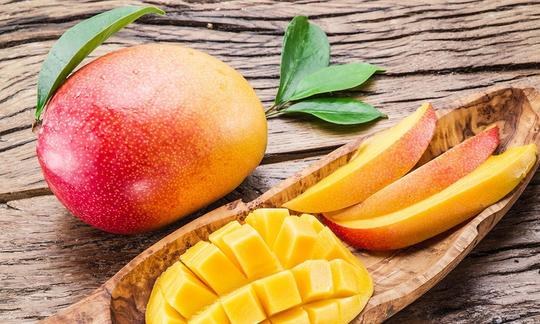

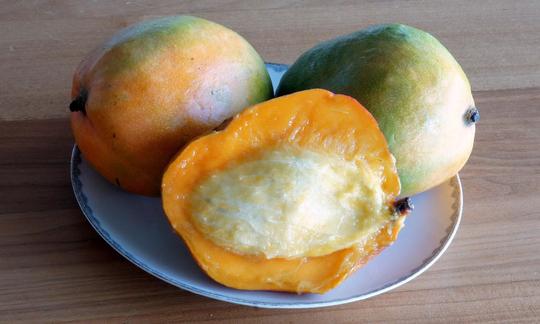

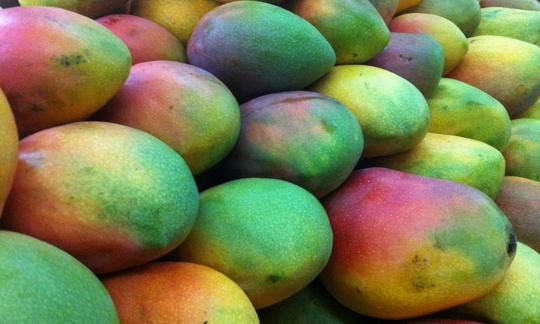

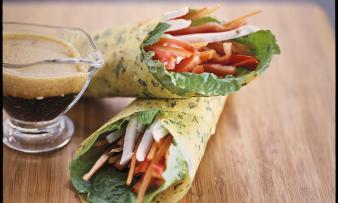
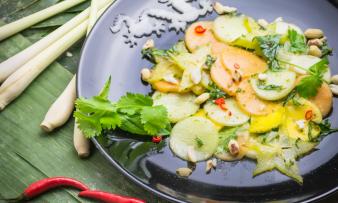
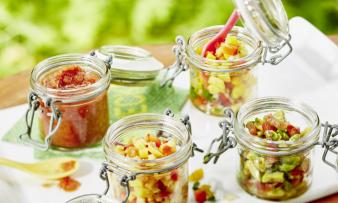





Comments